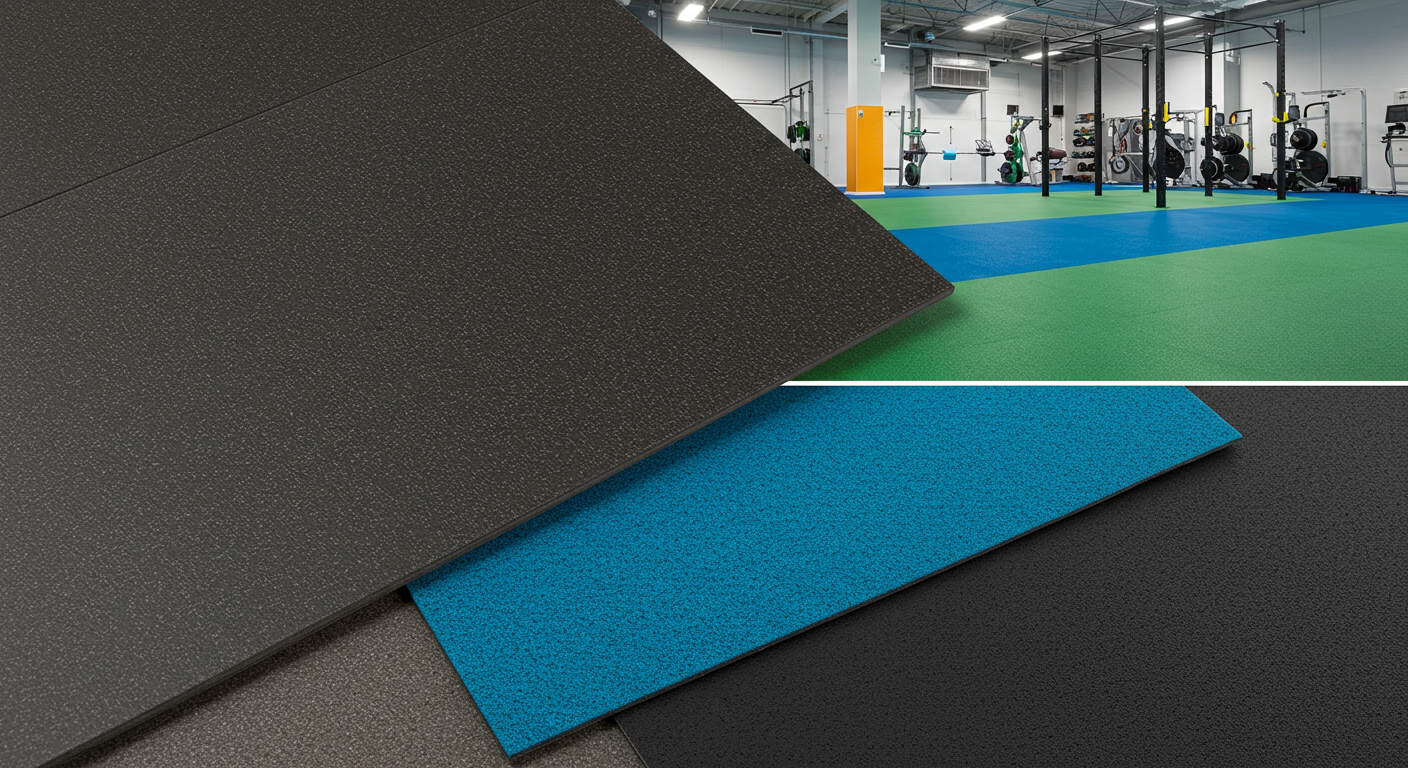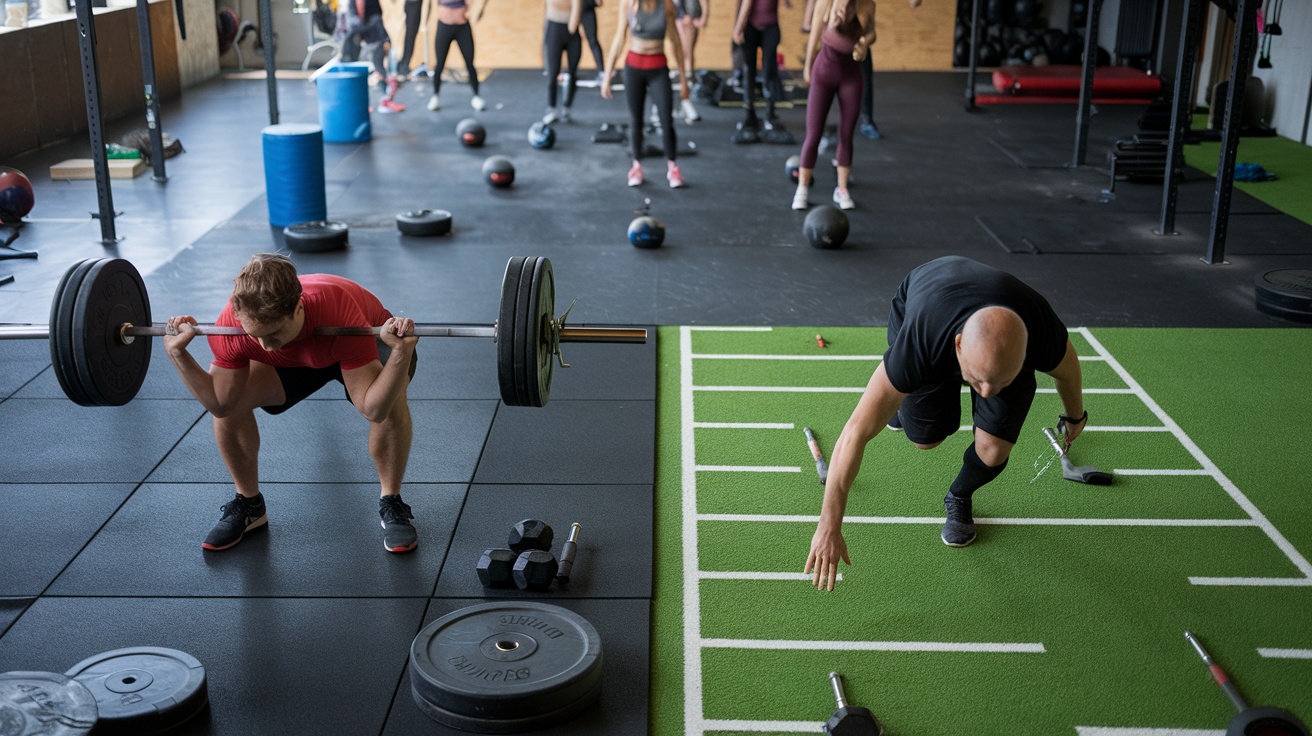Overwhelmed by gym flooring choices? Don’t know where to start, and terrified of making a costly mistake that could lead to injuries or constant repairs? This guide cuts through the confusion, providing clear, actionable advice to help you choose the perfect gym flooring.
The best gym flooring depends on your specific needs, but rubber flooring is the most popular overall choice due to its durability, shock absorption, and versatility. Suitable for weightlifting to general fitness, making it a great starting point.
 BYFIT Gym Flooring Options
BYFIT Gym Flooring Options
Choosing gym flooring is like building a solid foundation for your fitness journey—essential for success! Don’t worry, this guide breaks it down. Keep reading to discover everything you need.
What is the most popular gym flooring?
Confused by the endless flooring options? It’s easy to feel lost, unsure which type best suits your needs and worried about wasting money. Let’s simplify things by exploring the top contenders, making your decision easier and more informed.
Rubber flooring1 is the champion. It’s the workhorse of gyms, valued for its strength, cushioning, and adaptability to various workout styles.
 Popular Rubber Gym Flooring
Popular Rubber Gym Flooring
What type of flooring is best for CrossFit?
CrossFit demands a floor that can handle intense, varied movements. You need something that can take a beating. Rubber, especially rolled or interlocking tiles2, is generally best. It protects athletes during jumps and heavy lifts, with durability for dropped weights and intense activity. BYFIT’s hexagonal design (Patent ZL2023006) offers unmatched durability, lasting 5 years compared to 1.5 years for standard floors.
What flooring is used in commercial gyms3?
Commercial gyms face high traffic and diverse activities, requiring a floor that handles everything. Rubber is most common, but the type varies. Rolled rubber is used in open areas; interlocking tiles are popular in weight rooms. Some might include turf or padded areas for specific exercises.
| Flooring Type | Common Use in Commercial Gyms |
|---|---|
| Rolled Rubber | Large open areas, general fitness zones |
| Interlocking Tiles | Weight rooms, free weight areas |
| Turf | Agility training, functional fitness |
| Padded Flooring | Stretching areas, bodyweight exercises |
Is rubber or foam better for gym flooring?
Both have a place. Rubber excels for heavy-duty use, weightlifting, and high impact due to density and durability. Foam is softer, more comfortable, and better for bodyweight exercises, yoga, and children’s areas. It’s less durable, and prone to damage from weights. BYFIT’s innovation makes rubber even better: our nano-coated foam reduces water absorption to 0.2% (vs 13% in standard foam), preventing expansion and mold even in extreme heat, and drastically cutting return rates.
What factors should I consider when choosing gym flooring?
Need gym flooring, but unsure what your space needs? Avoid investing in something unsuitable for your activities. Considering these details ensures you make the right choice.
Choosing gym flooring means balancing factors like activity type, durability, budget, aesthetics, and maintenance.
](https://www.byfitgear.com/wp-content/uploads/2025/03/Choosing-the-Right-BYFIT-Gym-Floor.jpg) Choosing the Right Gym Flooring
Choosing the Right Gym Flooring
How do I choose the right gym floor?
It’s a multi-step process, consider the following factors, I made you a table:
| Factor | Consideration | BYFIT Advantage |
|---|---|---|
| Activity | What type of exercise? High-impact, weightlifting, yoga, or general fitness? | Offers specialized flooring for all activity types. |
| Durability4 | How much wear and tear? Will heavy weights be dropped? | Hexagonal cell tech (Patent ZL2023006) meets ASTM F2772, with minimal shock-absorption loss. |
| Budget5 | How much are you willing to spend? | Provides options for various budgets, with a focus on long-term value. |
| Aesthetics | Do you have a specific look or design in mind? | Offers a wide range of colors and styles, including customizable options. |
| Maintenance6 | How easy is it to clean and maintain? | Nano-coating cuts water absorption to 0.2%, tripling lifespan and minimizing maintenance. |
| Subfloor | What type of flooring is currently beneath? | Provides guidance on subfloor compatibility and preparation. |
| Installation | Consider installation costs. Interlocking tiles are generally DIY, while rolled rubber may require professionals. | Offers both DIY-friendly and professionally installed options. |
What is the most important quality of the materials used for floors?
Durability is arguably the most crucial. Gym flooring must withstand constant use, impacts, and dropped weights. A durable floor protects your investment, reduces replacements, and ensures safety. Choose BYFIT!
What are the disadvantages of rubber flooring?
Even the best has drawbacks:
- Odor: New rubber can have a strong smell, especially initially. It usually fades.
- Weight: Rubber is heavy, making installation harder, especially with rolls.
- Cost: Can be more expensive than options like foam.
- Staining: Some types can stain from certain liquids.
What are the different types of gym flooring?
Need different things in different areas? Want the best option for each? Don’t settle for one-size-fits-all. Understanding the differences lets you customize.
Gym flooring comes in many materials, each with pros and cons: rubber, foam, vinyl, carpet, and turf.
](https://www.byfitgear.com/wp-content/uploads/2025/03/Comparing-price-tags-of-different-flooring-types.jpg) Types of Gym Flooring
Types of Gym Flooring
What are the 4 types of flooring?
While there are more than four gym flooring types, broadly, we have:
- Resilient: Rubber, vinyl, linoleum. Offer some give, comfortable underfoot.
- Hard: Wood, laminate, concrete. Durable, less shock absorption.
- Soft: Carpet, some foams. Good cushioning, not for all gym activities.
- Specialty: Turf, for agility training or indoor sports.
What is the difference between vinyl and rubber flooring?
| Feature | Rubber Flooring | Vinyl Flooring |
|---|---|---|
| Material | Natural or recycled rubber | Synthetic (primarily PVC) |
| Durability | More durable, better for high impact/heavy weights | Resistant to scratches, damaged by dropped weights |
| Shock Absorption | Superior, protects joints, reduces noise | Less shock absorption |
| Cost | Often more expensive | Often more affordable |
| Maintenance | Easy to clean, may need occasional sealing | Easy to clean |
What are the benefits of rubber flooring?
Rubber offers many advantages:
- Durability: Handles heavy use, dropped weights, high impact.
- Shock Absorption: Protects joints, reduces noise.
- Safety: Non-slip, even when wet.
- Versatility: For a wide range of activities.
- Easy Maintenance: Generally easy to clean.
- Eco-Friendly: Available in recycled options. True eco-floors need dual credentials, like BYFIT!
What is the best thickness for gym flooring?
Know the material, but not how much? Too thin risks damage; too thick wastes money. Match thickness to workout intensity.
Best thickness depends on use. Thinner (8mm) suits lighter activities; thicker (15mm+) is better for heavy weights and high impact.
](https://www.byfitgear.com/wp-content/uploads/2025/03/Rubber-Flooring-Thickness-Comparison.jpeg) Gym Flooring Thickness Guide
Gym Flooring Thickness Guide
Is 8mm gym flooring7 enough?
8mm can work for home gyms with moderate use, bodyweight exercises, light weights, and cardio. It may not protect enough for heavy lifting or high impact. Micro-cracks from daily 200kg barbell drops silently destroy floors.
Is thicker gym flooring8 better?
Thicker generally means better shock absorption, noise reduction, and subfloor protection. Better for heavy lifting, CrossFit, dropped weights. It also costs more.
How thick should home gym flooring be?
Depends on your activities:
| Activity Level | Recommended Thickness (mm) |
|---|---|
| Light (bodyweight, yoga, cardio) | 6 – 8 |
| Moderate (light weights, some jumping) | 8 – 10 |
| Heavy (heavy weights, CrossFit, powerlifting) | 12 – 15+ |
How do I maintain and clean gym flooring?
Want your investment to last, without cleaning becoming a full-time job? Improper cleaning can damage the floor or cause odors. Follow these steps for a clean, long-lasting floor.
Regular cleaning and maintenance preserve appearance, performance, and hygiene.9
 Cleaning Gym Flooring
Cleaning Gym Flooring
How do you clean stinky gym mats?
- Ventilation: Good airflow helps dissipate odors.
- Regular Cleaning: Wipe after use with a damp cloth or water/mild detergent.
- Deep Cleaning10: Periodically use a gym floor cleaner or water/vinegar to disinfect.
- Baking Soda11: Sprinkle, let sit, then vacuum to absorb odors.
Can you mop rubber gym flooring?
Yes. Use a damp (not soaking) mop and mild detergent or gym floor cleaner. Avoid harsh chemicals, bleach, or abrasives.
How often should I clean my gym floor?
| Frequency | Task |
|---|---|
| Daily | Wipe spills, sweat, debris. Sweep or vacuum to remove loose dirt/dust. |
| Weekly | Mop with mild detergent or gym floor cleaner. |
| Monthly/Quarterly | Deeper cleaning, disinfect, address stains/odors. |
How much does gym flooring typically cost?
Need to budget, and avoid surprise expenses? Get a realistic price range, understanding cost factors.
Cost varies widely by material, thickness, quality, and brand. Options range from budget foam tiles to premium rubber rolls.
 Gym Flooring Cost Comparison
Gym Flooring Cost Comparison
What is the average price of gym flooring?
| Flooring Type | Average Price (per sq ft) |
|---|---|
| Foam Tiles | $1 – $4 |
| Rubber Tiles | $2 – $8 |
| Rubber Rolls | $1 – $5 |
| Vinyl Flooring | $2 – $6 |
| Turf | $3 – $8 |
These are estimates; request a quote from BYFIT ([email protected]).
How do I choose rubber flooring12?
Consider:
- Type: Rolled, interlocking tiles, or mats?
- Thickness: Based on intended use.
- Density: Higher density = better durability.
- Color/Finish: Choose a look that suits.
- Recycled Content: If eco-friendliness matters.
- Warranty: Check the manufacturer’s warranty.
BYFIT offers: 27-toxin GC-MS screening + ISO14001 certification.
What is the best flooring for heavy equipment?
Rubber is generally best for heavy equipment13: durable, dense, shock-absorbing. Protects the subfloor, reduces noise/vibration. Thicker rubber (12mm+) is recommended for very heavy equipment.
Conclusion
Choosing the best gym flooring is more than just buying the most expensive option. I suggest to consider your activities, budget, and maintenance, select the flooring that best fits your needs. This will give you a safe, durable, and enjoyable workout space for years to come.
-
Explore the advantages of rubber flooring, the top choice for gyms, known for its durability and versatility in various workout environments. ↩
-
Learn about interlocking tiles, a popular choice for weight rooms, and how they stack up against other flooring types for gym use. ↩
-
Discover the best flooring solutions for commercial gyms, designed to withstand high traffic and diverse activities effectively. ↩
-
Understanding the benefits of durable gym flooring can help you make an informed decision for your space. ↩
-
Exploring budget-friendly options for gym flooring can help you find the best value without compromising quality. ↩
-
Learning about maintenance practices ensures your gym flooring lasts longer and stays in good condition. ↩
-
Explore the pros and cons of 8mm gym flooring to determine if it’s suitable for your workout routine, especially for heavy lifting. ↩
-
Learn about the advantages of thicker gym flooring, including shock absorption and noise reduction, to enhance your workout experience. ↩
-
Understanding the benefits of regular maintenance can help you keep your gym flooring in top condition and extend its lifespan. ↩
-
Exploring deep cleaning methods will ensure your gym flooring remains hygienic and odor-free, enhancing the overall gym experience. ↩
-
Discover how baking soda can effectively eliminate odors and maintain your gym mats, making cleaning easier and more efficient. ↩
-
Learn about the advantages of rubber flooring, including durability and shock absorption, to make an informed decision for your gym. ↩
-
Find out the best flooring solutions for heavy gym equipment to ensure safety and durability in your workout space. ↩

](https://www.byfitgear.com/wp-content/uploads/2025/03/3.jpeg)

